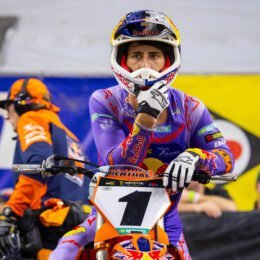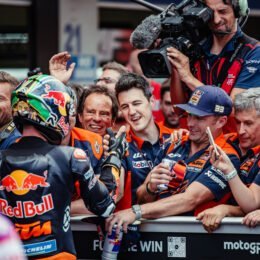THE COMPLETE MACHINE; THE COMPLETE PACKAGE
KTM’s motorsports activities have delivered almost 400 FIM titles. But what’s been the best motorcycle of the bunch? Step forward the KTM 250 SX-F; a bike that recently bagged its 15th MX2 Motocross World Championship from the last 20 seasons. Here is some of the story…
By Adam Wheeler

PC: Ray Archer
20 seasons, 15 championships, 10 different riders, 1 team: the numbers for the KTM 250 SX-F speak for themselves. In the hands of the Red Bull KTM Factory Racing Team, the bike has been the reference for results, power and consistent performance for almost two decades and across a period of development that has welcomed fuel injection, electronics, steel chassis refinement and anti-squat concepts, huge advances in suspension hardware, bike behavior and alterations to rider ergonomics.
The upward narrative of the KTM 250 SX-F almost mirrors that of the company itself when it comes to R&D evolution and general expansion: the bike became the ultimate expression of 250cc four-stroke racing around the same time that KTM started to conquer all competitions, lead market sectors and outstripped all rivals to become Europe’s largest two-wheel manufacturer by a hefty margin.
It was a difficult birth, however. KTM had the excellent two-stroke, the KTM 125 SX, and won the 125cc world championship with three different riders in 2000, 2001 and 2003. It was proven and potent, but the four-strokes were coming. 2003 was period of intense experimentation for KTM’s R&D department and race division for the early versions of the KTM 250 SX-F.
“It was very over-engineered,” current Project Leader Dirk Gruebel (then a lead technician with the race team) remembers now. “It had gear-driven cams, some special stuff. But it was a disaster. There was too much frequency, and it would just push until the next part broke. It was one thing after another. It was a good development story. We could run full prototypes in the world championship and then pre-production models in the U.S. because of the rulebooks and it was not until then we got to that first pre-production model that we made big steps with reliability. Then we were able to make progress every year and be the reference in the class for horsepower.”

PC: Ray Archer
A prototype KTM 250 SX-F first appeared on a world championship racetrack in March 2003, at Bellpuig for the Grand Prix of Spain and was ridden by Erik Eggens. The bike was notoriously stubborn to start and was temperamental in terms of durability but was extremely quick. It was then shelved as work continued back in Mattighofen. Also back in the office was future KTM Motorsports Director Pit Beirer, whose career as a Grand Prix rider himself had come to an abrupt halt.
“Historically KTM has already had a strong engine in many different projects but sometimes also not so reliable!” Beirer smiles now. “We wanted to keep all that engine power but had to make sure it lasted. It was very intense. We needed to use the full potential of the company and I’m very happy we did it all together. There was always a huge motivation in KTM Motorsports, both before my time and then when I joined, and nothing changed in that way. I just think we really progressed as a race department over the years.”

PC: Ray Archer
On 21st March, the 2004 FIM Motocross World Championship opened at the sandy Zolder circuit with the new ‘MX2’ and ‘MX1’ (later to become ‘MXGP’) format, replacing 125, 250 and 500cc categories. The KTM 250 SX-F leapt out of the gate. Marc de Reuver won the first moto in the Belgian rain while Ben Townley would take the second and the Grand Prix win. The reign had begun. “I think our bike is the most competitive on the track,” De Reuver said that day. “We have done a lot of testing and it is the most powerful.”

Townley would win the inaugural MX2 title. He called the KTM 250 SX-F a “rocketship; it was embarrassingly fast”. The New Zealander was the first rider of ten that has included a South African, three Frenchmen, a Dutchman, a Latvian, a German, a Spaniard and now an Italian. Townley triumphed in 2004 but it was a fertile time for 250cc four-stroke development. The KTM 250 SX-F came close in 2005 – and the first serial production bikes did not reach the hands of the public until 2006 – but it was not until 2008 when KTM held the gold number plate again. Afterwards MX2 turned a shade of orange and only missed championships in 2015 and 2021.
“The first MX2 title under my leadership in KTM Motorsports felt very special, and that was with Tyla Rattray [2008] and from that moment a super-successful time started for us in racing, firstly with KTM and then the whole group with different brands,” remembers Pit Beirer. “It is all based on the change of the working method and the development method that we found in that first ‘08 title. Those first MX2 championships mean a lot to me because they changed KTM Motorsports and led to some very good times.”

PC Ray Archer
Beirer was not only a management architect for KTM’s racing activities but he also guided an internal culture that was hungry for success. The KTM 250 SX-F was example of a bike that thrived in this environment and the KTM 350 SX-F was a ground-breaking product of the same system that would go on to rule the other motocross category, MX1, from 2010 until 2014. Red Bull KTM swept the entire world championship for half a decade and then again in 2017 and 2018.
The KTM 250 SX-F has never lost its status as one of – if not the – fastest bikes in the category but it has also become stronger and more versatile. The platform has created high standards, intense demand and enjoyed relentless achievement via a team that has changed staff, riders and negotiated championships that have roamed the continents and stretched to 20 dates.

PC: Ray Archer
“For us it is super-important that we live ‘ready to race’. That is where it starts,” Beirer says. “We build the bike together with our engineers immediately with top riders but also for the hobby rider. We want a bike that is easy to use but with a lot of power. Now that’s easy to wish for, but not so easy to do! I think we have had a consistent push to reach that. We don’t want a super-rocket that nobody else can ride apart from Jeffrey Herlings or young guys like Andrea Adamo or Liam Everts. If you have that easy-but-strong bike then it means you can bring guys into the team and they can immediately go fast. But that’s still not enough to win a title; you need a strong bike in every area. If you over-jump then you need the most resistant suspension but to save energy then you also need the softest and most effective suspension. It is not so simple, and it is a huge effort that we take very seriously. I think also we kept the promise that when we said we would go with a big effort into MotoGP that we would not forget where we came from. We never stopped thinking about the next KTM 250 SX-F, and I know what is in the pipeline and the next generation will come. We will never sit still in that class.”
“I first started working on the KTM 250 SX-F in 2011 as an apprentice and that was the first phases of Fuel Injection and when we changed the linkage system,” says current Red Bull KTM Technical Co-Ordinator and Gruebel’s successor Harry Norton. “It seems like every year we’ve been able to find or make improvements.”
“KTM has a long history in racing and a very good pedigree,” he adds. “I think it is simply because of the people behind the scenes, the riders’ input, and the passion the group has for the project. By the group I also mean R&D, motorsport staff, the race team and the practice crew. They collectively pool their ideas and energy together and things get done.”

PC: Ray Archer
Norton, who has his own world championship experience thanks to the two titles claimed with Tom Vialle in 2020 and 2022, has overseen a 2023 season where new recruits Andrea Adamo and Liam Everts rose to 1st and 2nd in the standings at one point, in their first year as Red Bull KTM factory riders. The team has depended on the ever-present work of staff like Valentina Ragni [Team Co-Ordinator], Gruebel back in Austria, Tony Cairoli as a fledgling Team Manager and Joel Smets as champion-maker trainer/coach but they also hired fresh, young mechanics. 2023 should have been a reset for the future but the MX2 train kept firmly on the rails.
“I think the team has a soul or a spirit; there is a basic hunger to win that means anyone who goes near it is there for one reason only. Somehow the team is creating a cool atmosphere,” says Beirer. “Last year, last summer, I was worried when Dirk said he would step away because he is one of our top development engineers and although he is at home and working on future projects, we would miss him at the racetracks. It was a hole in the team. There was a nervous moment but then we brought this young mechanic up to be a Technical Co-Ordinator; those were some big steps, but Harry has been fantastic. I feel he has a strong woman at his side in Valentina, but he still had to learn quickly. Also, Joel’s experience was very important: he’s training the riders so well. The package is strong but if you change a lot of personnel then there is also a risk. We knew we needed a ‘restart’ and thought about the future but the young riders we brought up have delivered so much excitement. Young team, new mechanics, a next generation of technicians, especially for things like electronics development: there is a lot of young blood. It is easy to talk now because everything has gone well…but we did not know how it would be last summer.”

PC: Ray Archer
The legacy of the KTM 250 SX-F is not only displayed by the many FIM certificates on the wall of the Motorsports HQ in Munderfing. All the work and the ideas behind the engine alone transitioned quite well to some unexpected places. “We were a pure two-stroke company and to go four-stroke meant we had to learn a lot of new technology, make it reliable and strong,” Beirer explains. “In the beginning you needed the double capacity of ‘cc’ to reach the same horsepower and nowadays you have a lot more than, say, an old 125cc two-stroke. We did it very well and that meant we had confidence for road racing and the new Moto3 regulations in 2012. We already had some good knowledge. For example, the rev limit they brought in for Moto3 was lower than the one we had for motocross in those days. We knew we had the parts and internals ready to make that step [KTM RC4 tech has subsequently won six Moto3 championships to-date]. It’s also why it is so important our motorsports center has all the disciplines under one roof because of these small reasons. What you learn, you can share, and that’s another part of the successful story.”
This year, the FIM MX2 Motocross World Championship was again won on the KTM 250 SX-F by Red Bull KTM Factory Rider Andrea Adamo. Watch the video below to celebrate KTM’s 15th MX2 World Championship.



